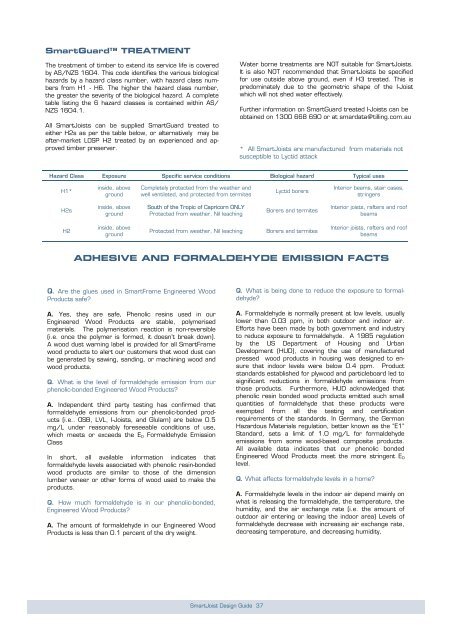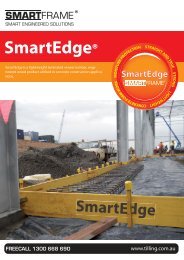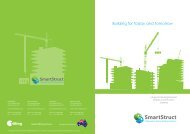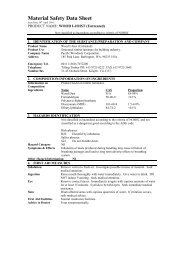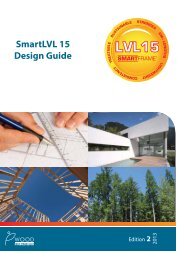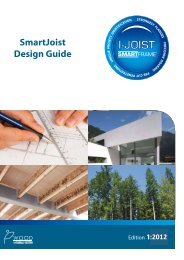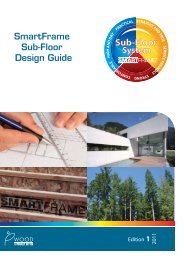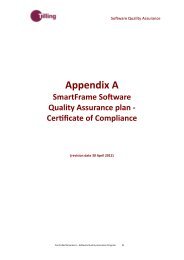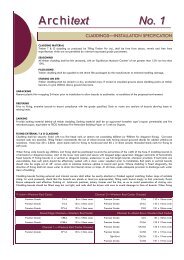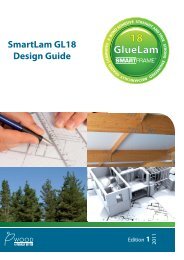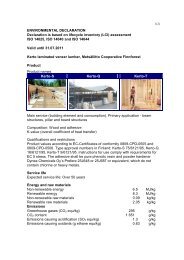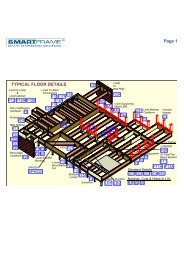FIRE SAFETY AND SOUND TRANSMISSIONFIRE SAFETYThe Building code of Australia became a performancebasedcode in 1996 (BCA96). The introduction of the BCAalong with the changes to AS1530.4 has seen Australiabrought into line with international standards for fire resistancetesting. The principle modification has been toexpress the test result in terms of the performance of thespecimen Fire Resistance Level (FRL) rather than to assigna single rating as had been the established practice. Theoutcome of the test is expressed as the number ofminutes for which the specimen fulfils the requirements ofeach of the three criteria, being:a) Structural adequacyb) Integrity; andc) Insulation, and expressed in that orderThe performance of a specimen is then given as the actualtime for which the specimen satisfied these criteria, butrounded down to the nearest regulatory requirements.E.g. 60/60/60.Ceiling systems may also be required to provide“Resistance to the Incipient Spread of fire” for a given periodof time. This requires the ceiling system to prevent thespread of fire within a roof/ceiling or floor/ceiling cavity byproviding adequate thermal insulation to combustibles inthis area, avoiding the danger of them igniting. To coincidewith the changes, the timber industry produced a setof manuals Multi Residential <strong>Timber</strong> Framed Construction(MRTFC) 1, 2 & 3, which outlined the BCA requirementsfor multi residential buildings, design criteria and constructiondetails which were designed to satisfy the BCA requirements.FIRE RATED FLOORS/CEILINGSThe best information available at this time concludes thatthe fire resistance for ceiling and floor/ceilings is achievedby the lining material and that alternative joist sizes andmaterial can be substituted in the various certified systems,providing they are designed to support the full loads.The thickness of the fire grade ceiling lining for the relevantFRL is the same as required in the tested systemsusing solid timber joists.Additional testing have concluded that the following layersof fire rated plasterboard can achieve the FRL and incipientspread of fire as listed in the following table:Fire gradeplasterboardFRLIncipient spreadof fire1 x 13 mm 30/30/30 01 x 16 mm 60/60/60 302 x 13 mm 60/60/60 302 x 16 mm 90/90/90 603 x 16 mm 120/120/120 60The above ratings can be achieved using standard firegrade plasterboard from some sheet manufacturers. Othermanufacturers may however require the use of specialfire rated board or may still require the number of layersoutlined in MRTFC 2.For further details on the various certified systems, seethe MRTFC manuals available through all State <strong>Timber</strong>Development Associations or contact the engineers on theSmartData Customer HelpLine on 1300 668 690.SOUND TRANSMISSIONThe ability of walls and floors to reduce noise is measuredover the most important part of the hearing range (from125 to 4000 cycles per second), and the results reducedto a “weighted sound reduction index” or R w value. In2004, the BCA introduced the addition of a SpectrumAdaption factor. This C tr factor takes into account lowerfrequency level sounds, and has been chosen in large part,in recognition of the problem of the high bass frequencyoutputs of modern home theatre systems and amplifiedmusic systems. Therefore, both the C tr and the R w of thebuilding element will now need to be considered.In addition to being rated for airborne sound transmission,floors are also rated by “Impact sound pressure level” orL’ n,w plus the spectrum adaption factor C l values that ratethe capacity of floor assemblies to control impact noisesuch as footfalls. The lower the L’ n,w + C l of the floor, thebetter the performance of the floor in terms of impactsound insulationThe BCA now requires a R w +C tr of 50 in floors betweensole occupancy units and between dwellings and a plantroom, lift shaft, stairway, public corridor, public lobby orsimilar.In 2004, the BCA introduced Deemed-to-satisfy provisionswhich require the L’ n,w + C l of a floor to be determined bytesting in the laboratory. The impact sound insulation requirementsfor floors in the BCA is L’ n,w + C l not more than62 for floor separating dwellings and floor separatingdwellings from a plant room, lift shaft, stairway, publiccorridor, public lobby or similar.The use of light-frame construction systems challengesdesigners to insulate against noise rather than simply relyingon the massiveness of heavy walls and floors. Excellentlevels of noise control can be achieved with good acousticsin wood framed structures surfaced with wood structuralpanels. Sound control can be achieved by applying floorand wall materials over isolated air spaces that absorbsound. The addition of resilient channels to support theceiling system independently increases the R w +C tr and L’ n,w+C l ratings.The best current understanding indicates that the“Certified Systems – Walls, Floors and Ceiling” as detailedin the MRTFC 2 can be used to closely approximate theR w +C tr and L’ n,w + C l rating of floor/ceiling systems with<strong>SmartJoist</strong> floor joists. Work is under way to further investigatethe link between joist types and impact sound insulation.For further details on the various certified systems, seethe MRTFC manuals available through all State <strong>Timber</strong>Development Associations or contact the engineers on theSmartData Customer HelpLine on 1300 668 690 or atsmartdata@tilling.com.au<strong>SmartJoist</strong> <strong>Design</strong> <strong>Guide</strong> 36
SmartGuard TREATMENTThe treatment of timber to extend its service life is coveredby AS/NZS 1604. This code identifies the various biologicalhazards by a hazard class number, with hazard class numbersfrom H1 - H6. The higher the hazard class number,the greater the severity of the biological hazard. A completetable listing the 6 hazard classes is contained within AS/NZS 1604.1.All <strong>SmartJoist</strong>s can be supplied SmartGuard treated toeither H2s as per the table below, or alternatively may beafter-market LOSP H2 treated by an experienced and approvedtimber preserver.Water borne treatments are NOT suitable for <strong>SmartJoist</strong>s.It is also NOT recommended that <strong>SmartJoist</strong>s be specifiedfor use outside above ground, even if H3 treated. This ispredominately due to the geometric shape of the I-Joistwhich will not shed water effectively.Further information on SmartGuard treated I-Joists can beobtained on 1300 668 690 or at smardata@tilling.com.au* All <strong>SmartJoist</strong>s are manufactured from materials notsusceptible to Lyctid attackHazard Class Exposure Specific service conditions Biological hazard Typical usesH1*inside, abovegroundCompletely protected from the weather andwell ventilated, and protected from termitesLyctid borersInterior beams, stair cases,stringersH2sinside, abovegroundSouth of the Tropic of Capricorn ONLYProtected from weather, Nil leachingBorers and termitesInterior joists, rafters and roofbeamsH2inside, abovegroundProtected from weather, Nil leachingBorers and termitesInterior joists, rafters and roofbeamsADHESIVE AND FORMALDEHYDE EMISSION FACTSQ. Are the glues used in SmartFrame Engineered WoodProducts safe?A. Yes, they are safe, Phenolic resins used in ourEngineered Wood Products are stable, polymerisedmaterials. The polymerisation reaction is non-reversible(i.e. once the polymer is formed, it doesn’t break down).A wood dust warning label is provided for all SmartFramewood products to alert our customers that wood dust canbe generated by sawing, sanding, or machining wood andwood products.Q. What is the level of formaldehyde emission from ourphenolic-bonded Engineered Wood Products?A. Independent third party testing has confirmed thatformaldehyde emissions from our phenolic-bonded products(i.e.. OSB, LVL, I-Joists, and Glulam) are below 0.5mg/L under reasonably foreseeable conditions of use,which meets or exceeds the E 0 Formaldehyde EmissionClassIn short, all available information indicates thatformaldehyde levels associated with phenolic resin-bondedwood products are similar to those of the dimensionlumber veneer or other forms of wood used to make theproducts.Q. How much formaldehyde is in our phenolic-bonded,Engineered Wood Products?A. The amount of formaldehyde in our Engineered WoodProducts is less than 0.1 percent of the dry weight.Q. What is being done to reduce the exposure to formaldehyde?A. Formaldehyde is normally present at low levels, usuallylower than 0.03 ppm, in both outdoor and indoor air.Efforts have been made by both government and industryto reduce exposure to formaldehyde. A 1985 regulationby the US Department of Housing and UrbanDevelopment (HUD), covering the use of manufacturedpressed wood products in housing was designed to ensurethat indoor levels were below 0.4 ppm. Productstandards established for plywood and particleboard led tosignificant reductions in formaldehyde emissions fromthose products. Furthermore, HUD acknowledged thatphenolic resin bonded wood products emitted such smallquantities of formaldehyde that these products wereexempted from all the testing and certificationrequirements of the standards. In Germany, the GermanHazardous Materials regulation, better known as the “E1”Standard, sets a limit of 1.0 mg/L for formaldehydeemissions from some wood-based composite products.All available data indicates that our phenolic bondedEngineered Wood Products meet the more stringent E 0level.Q. What affects formaldehyde levels in a home?A. Formaldehyde levels in the indoor air depend mainly onwhat is releasing the formaldehyde, the temperature, thehumidity, and the air exchange rate (i.e. the amount ofoutdoor air entering or leaving the indoor area) Levels offormaldehyde decrease with increasing air exchange rate,decreasing temperature, and decreasing humidity.<strong>SmartJoist</strong> <strong>Design</strong> <strong>Guide</strong> 37


